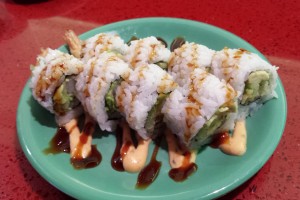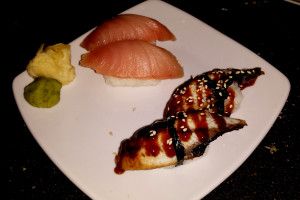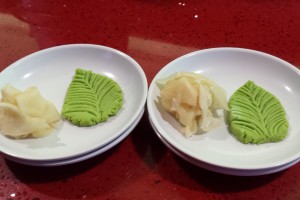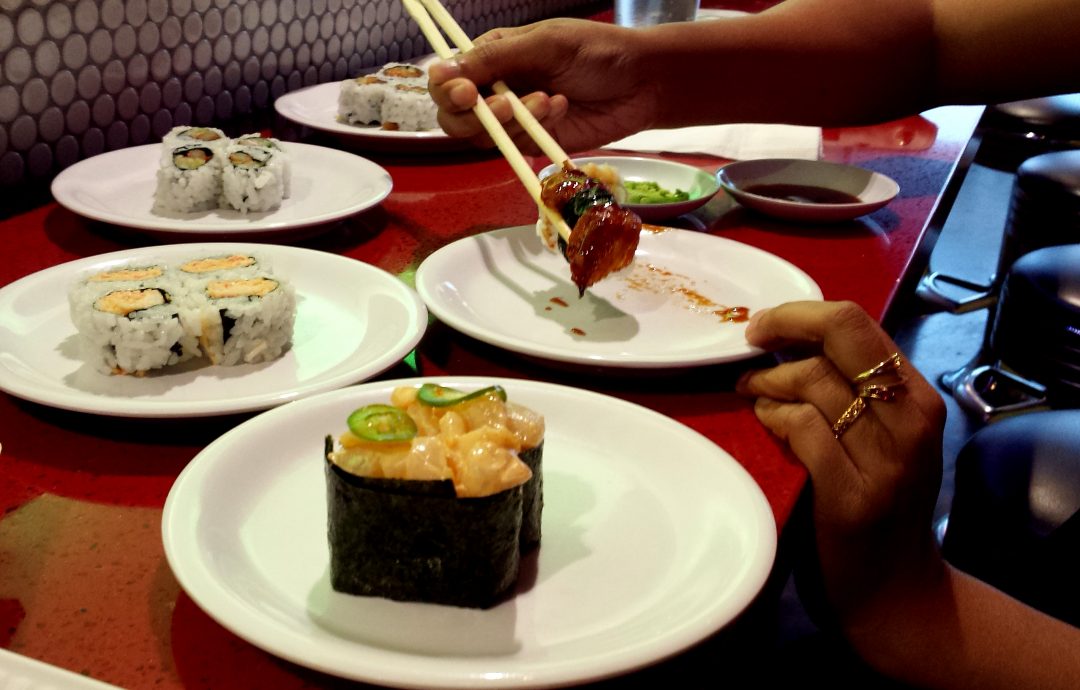
Sushi Basics for Beginners
On February 10, 2014 by Meghalee DasSushi is regarded as an acquired taste, more on a psychological level than a gustatory one. All of us are conditioned by childhood eating habits and cultural standards of what is considered appetizing and safe. This is why dishes with familiar flavors become comfort food, while others may make us “uncomfortable.” I first had a sushi roll in a hotel in Noida, India, when I went for a food review. I honestly don’t even remember what it tasted like, perhaps because I had already eaten many other dishes laid out for brunch. But today sushi has become one of my favorites. It is light, flavorful and every time I experience something new about it.

(Clockwise from top left): Yellowtail Nigiri, Whitefish Nigiri, Salmon Nigiri, Tuna Nigiri, Spicy Shrimp Rolls, Spicy Tuna Rolls, Crab Rolls and Wasabi and pickled ginger.
If someone has never tried sushi, the first thing that comes to mind is — “It’s raw!!!” (In my head, I always hear this sentence in Gordon Ramsey’s voice :P). I personally like my meat well done and fish deep fried. I cannot stand the smell and taste of any lightly cooked non-vegetarian food. So for the longest time I avoided sushi because I thought it would make me sick. But sushi is not necessarily always raw! It can consist of vinegared rice, seaweed, vegetables like carrot, avocado, cucumber, and fish, which may be marinated, cooked or raw. In fact, good sushi has no fishy smell at all because it is made with the highest quality and freshest fish. And the taste… how do I explain it… it is this melt-in-your-mouth, subtly flavored bite size treat, tasting different depending on the type of fish and condiments used.
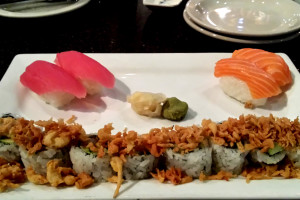
Tuna Nigiri (top left), Salmon Nigiri (top right) and Shrimp Tempura Rolls at Water Street Oyster Bar and Sushi Bar
Here are a few basics I have learned about sushi and its main variations based on my personal experience and preferences:
Maki: This is the most popular version of sushi, also called a sushi roll. Layers of vinegared rice, vegetables and cooked/grilled/smoked or raw fish are arranged on a sheet of seaweed (nori). This is rolled with a bamboo mat into a cylindrical shape and then cut into pieces. Most maki sushi have nori on the outside, except Uramaki which has rice on the outermost layer, as seen in the picture below.
Nigiri: A piece of cooked or raw fish is draped over a hand-pressed oblong mound of rice served with wasabi. The most common types of fish used are salmon (sake), tuna (maguro), yellowtail (hamachi), halibut (hirame), shrimp (ebi and amaebi), mackerel (saba), squid (ika) and eel (unagi and anago), which is always cooked.
Sashimi: Thinly sliced, very fresh raw fish is arranged beautifully and served without rice. Depending on the type of fish, it can be sometimes marinated in salt, soy sauce, sesame oil or white rice vinegar, which act as a preservative. Sashimi is always uncooked and very few ingredients are used in order to preserve the delicate and simple flavor of the fish.
Besides these, there are many other types of sushi like inari (fried tofu pouches stuffed with rice), temaki (cone shaped sushi), chirashi (scattered sushi, with raw fish and vegetables served over rice) and so on.
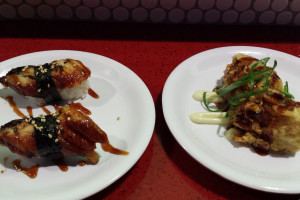
Unagi nigiri (left) and inari sushi stuffed with spicy tuna, crab and served with wasabi mayo, unagi sauce and sesame seeds
My favorite way of eating sushi is to mix a tiny bit of wasabi in soy sauce and lightly dip the roll into it. But if other condiments are provided with the sushi, I skip this step. You don’t want to imply to your host that you don’t like the original flavors! Ideally chopsticks are used but Japanese etiquette says you can pick sushi rolls and nigiri with your fingers. Sashimi is always eaten with chopsticks, although some restaurants provide forks if you request them. (But try the chopsticks, it’s fun!) It is also polite to eat it in one bite, at the most two bites without putting it back on the plate. The nigiri is usually dipped upside down in the soy sauce but I sometimes forget to do that and dip the rice part first.
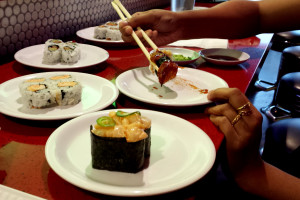
Ready to eat the delicious Unagi Nigiri and Spicy Scallop Nigiri (foreground) at Roll On Sushi Diner
If you are trying it for the first time, I would suggest go for the rolls. Most popular ones are California, Shrimp Tempura, Salmon, Spicy Tuna and Caterpillar roll (which uses avocado and eel, not caterpillars!) Once you are used to the taste, you can try the nigiri. My favorites are yellowtail, shrimp and eel. Be careful about fish like escolar, as some people may get stomach cramps after eating it. When you are comfortable with the taste of the fish, try the sashimi. It is the most expensive, as the freshest possible fish is used to make it. Thin slices of pickled ginger serve as a palate cleanser while sampling different varieties of sushi.
If you are celebrating a special occasion and are ready to splurge, check out if the restaurant has the Omakase tradition. It’s a Japanese phrase meaning “I will leave it to you”, where you let the chef decide the menu and surprise you with a series of dishes from the lightest to the heaviest, and not limited to only sushi.
I once saw a delightful documentary on Netflix called Jiro Dreams of Sushi. It focuses on the 85-year old sushi master Jiro Ono, owner of the Michelin three-star restaurant Sukiyabashi Jiro, and his mission to perfect the process of making sushi. It shows the years of training that goes into becoming a reputable sushi chef so that one can recognize the flavors, textures, and follow the necessary safety standards.
There are many features and varieties I have not touched yet because I have so much to learn about them. Creating sushi is a form of culinary art but truly appreciating it also needs an understanding of the various subtle nuances associated with it. Hopefully, I will keep exploring and discovering more aspects of this wonderful delicacy. Until then, sayonara!

